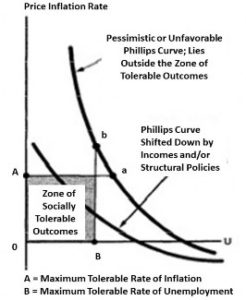NAIRU — closer to religion than science
Lars Syll
The non-accelerating inflation rate of unemployment (NAIRU) is a level of unemployment postulated by some economists below which inflation would be expected to rise. Monetary policy conducted under the assumption of a NAIRU involves allowing enough unemployment in economy to prevent inflation rising above a given target figure. Econ- omist Milton Friedman argued that a natural rate of inflation followed from the so-called Phillips curve. [Ed]
According to Mike Konczal [1]:
“Once we see how weak the foundations for the natural rate of unemployment are, then the other arguments for pursuing rates of unemployment economists once thought impossible become clearer. Wages can increase at the expense of corp- orate profits without causing inflation. The harder we push on improving output and employment, the more we learn how much we can achieve on those two fronts. That hopeful idea is the polar opposite of a natural, unalterable rate of unemployment. And it’s an idea and attitude that we need to embrace if we’re to have a shot at fully recovering from the wreck- age of the Great Recession.”

The NAIRU does not hold water simply because it has not existed for the last 50 years. But still today ‘New Keynesian’ macroeconomists use it – and its cousin the Phillips curve – as a fundamental building block in their models.
Why? Because without it ‘New Keynesians’ have to give up their – again and again empirically falsified – neoclassical view of the long-run neutrality of money and the simplistic idea of inflation as an excess-demand phenomenon.
The NAIRU approach is not only of theoretical interest. Far from it. The real damage done is that policymakers that take decisions based on NAIRU models systematically try to implement austerity measures and kill off economic expansion. Peddling this flawed illusion only gives rise to unnecessary and costly stagnation and unemployment.
According to Roger Farmer [2]:
“Defenders of the [NAIRU theory] might choose to respond to these empirical findings by arguing that the natural rate of unemployment is time varying. But I am unaware of any theory which provides us, in advance, with an explanation of how the natural rate of unemployment varies over time. In the absence of such a theory the [NAIRU theory] has no predictive content. A theory like this, which cannot be falsified by any set of observations, is closer to religion than science.”
Source: Real World Econ Rev, 5 Jan 2021 https://rwer.wordpress.com/2021/01/05/nairu-closer-to-religion-than-science/
-
Konczal, M. How low can unemployment go? Economists keep getting the answer wrong. The April jobs report adds to the debate about whether a “natural” rate of unemployment exists. https://www.vox.com/the-big-idea/2018/5/4/17320188/jobs-report-natural-rate-unemployment-inflation-economics-april
- Farmer, R. The Natural Rate Hypothesis: an idea past its sell-by date. https://www.bankofengland.co.uk/-edia/boe/files/quarterly-bulletin/2013/the-natural-rate-hypothesis-an-idea-past-its-sell-by-date.pdf
Comment from Dr Geoff Davies
January 6, 2021
NAIRU is a blatant fudge. We know that unemployment in Australia through the 1950s and 1960s averaged at 1.3%. Inflation averaged around 3%. Other OECD countries were not much higher. Which is impossible according to the NAIRU.
Profound ignorance, wilful ignorance, whatever, it should have been laughed out of contention before it ever got published or used. As usual there are beneficiaries – 5% or more unemployment tips the power balance to bosses, who naively think their best interest is served by an insecure and underpaid workforce. But all it does is keep the economy stuttering.



























